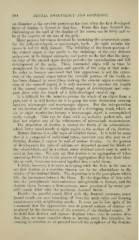Page 584 - My FlipBook
P. 584
594 DENTAL EMBRYOLOGY AND HISTOLOGY.
est diameter at the cervical portion at the time uhen the first developed
layer of dentine is formed at that line. From this time forward the
thickening of the wall of the dentine of the crown can be truly said to
be at the expense of the size of the pulp.
]\Iany persons have been deceived by mistaking the microscopic organ
for the' fully-developed, or macroscopic, tooth. At eight months the
crown is not yet fully formed. The infolding of the lower portion of
the enamel organ is due partly to the shrinkage of the very delicate
pulp-tissue at its deepest extremity and partly to the fact that the deep-
est edge of the enamel organ always precedes the specialization and full
development of the pulp. These contracted edges will in time be
straightened by the expansion and growth of the pulp at that point.
In order to become convinced that this appearance is not the exten-
sion of the enamel organ below the cervical portion of the tooth, as
has been claimed by some (thus making the cement organ a continua-
tion of the enamel organ), it is only necessary to measure the length
of the enamel organ in its different stages of development and com-
pare these Avith the length of a fully-developed enamel cap.
It is difficult for the mind to picture the whole of an object from a
part, and it is still harder for it to grasp the wide distinction existing
between microscopic and macroscopic objects. But the interpretation
of the location of the cervical margin of a developing tooth, which at
six or eight months has become a macroscopic object, is accomplished
easily enough. This can be done with an ordinary pocket-rule, and
does not require any of the refinements of microscopic measurement.
The deposition of dentine is aroimd the fibrils of the odontoblasts,
which latter stand nearly at right angles to the surface of the dentine.
Mature dentine is a solid mass of calcified tissue. It is held by some
that it is composed of individual tubes; however true this may be of
forming dentine, it cannot be said of mature dentine. In the process
of development the salts of calcium are deposited around the fibrils of
the odontoblasts, and in a certain sense dentinal tubuli may be said to
exist at that time. AVe may say that dentine is an aggregation of tubes
containing fibrils, but in the process of aggregation they lose their iden-
tity as such, becoming cemented together into a solid tissue.
I think, however, it is more in keeping with the facts in the case to
say that dentine is a secretion thrown out by the odontoblasts in the
meshes of the dentinal fibrils. The deposition is in the protoplasm which
fills the interspaces between the fibres. By the deposition of lime salts
into the ])roto])lasmic basis-substance calcoglobulin is formed, and the
dentine tissue becomes a homogeneous mass ])enetrated by many par-
allel canals filled with the persistent dentinal fibrils.
Besides the parallel canals filled with the dentinal processes, many
lateral canals are seen branching off from the main tubes and forming
anastomoses with neighboring canals. It must not be lost sight of for
a moment that the appearances seen in ground sections of dentine are
produced by the destruction of the contents of the dentinal canals. If
we hold that distinct and separate dentinal tubes exist in mature den-
tine, then we must consider them as having many fine branches, in-
creasing in numbers as we proceed toward the periphery of the dentine.


